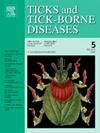Uneven temporal distribution of piroplasms (Piroplasmida: Babesiidae, Theileriidae) in Haemaphysalis concinna in an urban biotope of the Western Palearctic focus region of this tick species
IF 3.4
2区 医学
Q2 INFECTIOUS DISEASES
引用次数: 0
Abstract
Haemaphysalis concinna is a Palearctic tick species known as a potential or proven vector of several pathogens, including a broad spectrum of Babesia and Theileria species. The aim of this study was to examine the monthly presence of these piroplasms in H. concinna specimens collected from the vegetation of an urban habitat in Budapest, Hungary, in 2019 and 2020. The questing abundance of H. concinna was highest in June. By contrast, the occurrence of T. capreoli in unfed H. concinna peaked in April, and was significantly more common in the spring, than in the rest of the year. Among the detected eleven Babesia genotypes, two were present only in nymphs and adults of H. concinna. These were identical in the amplified part of their 18S rRNA gene to piroplasms reported from the Far East. Three further Babesia genotypes, however, showed genetic heterogeneity and were also carried by larvae. Babesia-infected nymphs and adults were most common in May and July.
In conclusion, the results of this study show that in a questing population of H. concinna the highest monthly prevalence of Babesia and Theileria spp. may be different from each other and from the peak abundance of carrier ticks. Based on previous reports on the effect of tick-borne pathogens on other species of ticks, the factors that may influence this phenomenon in H. concinna may include changes in the metabolism and behavior (host finding and feeding success) as well as survival rate of infected ticks. Further studies will be necessary to clarify this.
在古北西部地区的城市生物群落中,中国血蜱的螺质体(螺质体:巴贝斯虫科,蠓科)的时间分布不均匀
conconna血蜱是一种古北蜱,被认为是几种病原体的潜在或已证实的媒介,包括广泛的巴贝斯虫和伊氏杆菌。本研究的目的是检查2019年和2020年从匈牙利布达佩斯的一个城市栖息地的植被中收集的黄貂鱼标本中这些梨原体的每月存在情况。在6月份,红腹小蠊的搜寻丰度最高。相比之下,在未喂食的白腹大蠊中,卡氏滴虫的发生在4月达到高峰,在春季明显比其他季节更常见。在检测到的11种巴贝斯虫基因型中,有2种基因型仅存在于棉铃虫若虫和成虫中。这些人的18S rRNA基因扩增部分与来自远东的螺质相同。然而,另外三种巴贝斯虫基因型表现出遗传异质性,并且也由幼虫携带。感染巴贝虫的若虫和成虫在5月和7月最为常见。综上所述,本研究结果表明,在一个调查种群中,巴贝斯虫和伊氏蜱的最高月流行率可能彼此不同,也可能与载体蜱的最高丰度不同。根据以往关于蜱传病原体对其他种类蜱的影响的报道,影响这一现象的因素可能包括受感染蜱的代谢和行为(宿主发现和摄食成功)以及存活率的变化。需要进一步的研究来澄清这一点。
本文章由计算机程序翻译,如有差异,请以英文原文为准。
求助全文
约1分钟内获得全文
求助全文
来源期刊

Ticks and Tick-borne Diseases
INFECTIOUS DISEASES-MICROBIOLOGY
CiteScore
6.90
自引率
12.50%
发文量
185
审稿时长
6-12 weeks
期刊介绍:
Ticks and Tick-borne Diseases is an international, peer-reviewed scientific journal. It publishes original research papers, short communications, state-of-the-art mini-reviews, letters to the editor, clinical-case studies, announcements of pertinent international meetings, and editorials.
The journal covers a broad spectrum and brings together various disciplines, for example, zoology, microbiology, molecular biology, genetics, mathematical modelling, veterinary and human medicine. Multidisciplinary approaches and the use of conventional and novel methods/methodologies (in the field and in the laboratory) are crucial for deeper understanding of the natural processes and human behaviour/activities that result in human or animal diseases and in economic effects of ticks and tick-borne pathogens. Such understanding is essential for management of tick populations and tick-borne diseases in an effective and environmentally acceptable manner.
 求助内容:
求助内容: 应助结果提醒方式:
应助结果提醒方式:


